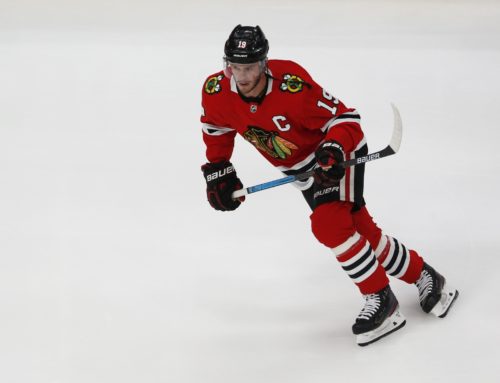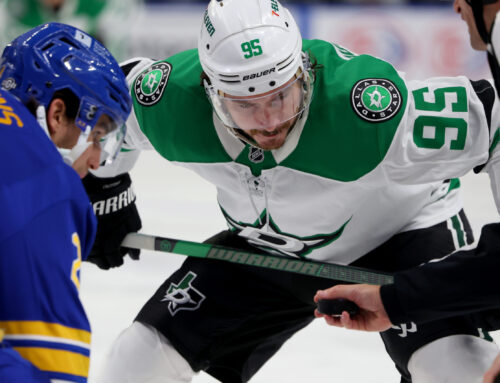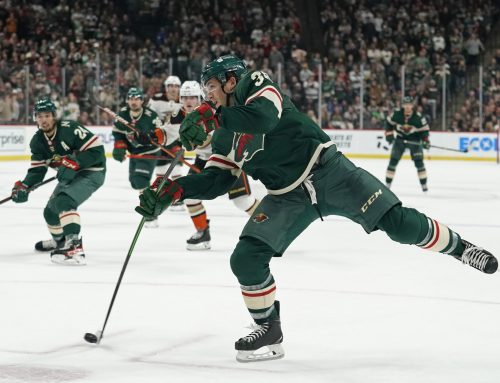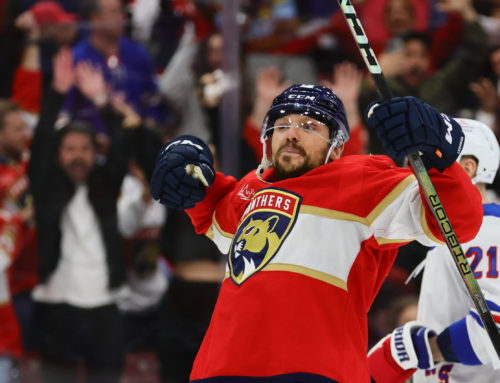Head on over to the Dobber Shop to grab your copy of the 2023-24 Dobber Hockey Fantasy Guide! It has everything fantasy owners need for their upcoming drafts, and it's constantly updated through training camps. Get a head start on your league mates and support what we do all at the same time.
*
The Leafs signed their superstar and he's going to be around for a long time:
That will mean Auston Matthews, barring something odd, will be the highest paid player in a year's time.
For fantasy, this doesn't change much for the upcoming campaign, but it is a hefty, hefty price tag down the road in cap leagues. That he is starting to hit and especially block shots at a high rate for a forward helps his fantasy value immensely, but 40 goals, 85 points, 350 shots, and 80 hits for the league-leading cap hit is probably not good value. He needs to get back to 55+ goals and 100+ points. Cap leaguers have a decision to make.
*
Something caught my eye on Wednesday because it's not a rumour, it's directly from the player. Some European NHLers are doing a fan tour and there was an interesting quote from Elias Pettersson to reporter Dan Rosen:
Pettersson is entering the final year of his deal, and he'll be an RFA after the season. He will be an unrestricted free agent the year after, though, and the cap is expected to go up a lot in the next two seasons. Pettersson signing a one- or two-year extension to try and cash huge in 2025 feels like something a lot of players are doing, so it doesn't feel unrealistic. This is definitely something to monitor because he's the single most important piece of their future.
*
Looks like Edmonton will be locking up defenceman Evan Bouchard:
Their cap situation prohibited a long-term (and much higher AAV) extension and he’ll be one year from UFA status when this new deal runs out. It will also end at the same time Leon Draisaitl becomes unrestricted. This team has two years to get to the Stanley Cup before they have a lot of decisions to make.
*
Alexis Lafrenière also signed an extension, his being for two years just north of $2.3M a season. I really, really wish teams would offer-sheet more. There is no reason why a half-dozen rebuilding franchises didn't put in a $4M AAV offer for Lafrenière other than cowardice.
*
There are two fantasy hockey draft seasons: the first is before training camp starts, and the second is during training camp/exhibition. The first season has little information; there may be some players with short- or medium-term injuries suffered in the summer that haven't been reported, we usually don't know how well (or not) players injured last season are recovering, we can only guess at line combinations, and there are still more transactions to come.
One example of this imperfect information is Andrei Svechnikov. He should be well into his on-ice rehab by now as he recovers from the knee surgery he had in March, but updates have been sparse, and there hasn't been a lot of chatter regarding his status for the first game of the regular season. Anyone drafting today has to gamble on whether he'll be his usual self for Game 1, maybe needs a dozen games to get up to speed or won't start the season on time at all. Anyone drafting after training camp starts will have a lot more information on Svechnikov's health, but so will everyone else in that fantasy league. It takes a bit of the risk out of the pick, but it would also take some of the value/upside out of it. That is the balancing act of drafting before Labour Day.
I'm going to take the next several Ramblings to go over one player I'm targeting from each team in my early drafts. They might just be good draft values regardless, or they may be players with murky near-term futures that have risk, but also have upside because of that risk. We are going to use early ESPN ADPs, which are wonky but the best we have now outside of Underdog Fantasy, but I don't think enough of our readers play on that site for it to be the best approach. Other data will be from Frozen Tools or Natural Stat Trick, unless otherwise indicated.
We will start with the Atlantic Division.
Boston – Pavel Zacha (ESPN ADP: 225.3, Forward 135)
It would seem impossible that Boston's top-line centre is being drafted outside the top-200 picks, but I have done one money draft so far, with small rosters, and he wasn't taken among the 192 selections. He is ranked higher on Yahoo!, so there is some scattered ranks depending on which site is referenced.
Regardless, Zacha easily had his best offensive season in 2022-23 with 21 goals and 57 points. He shot 16%, but he already had one season of 16.5% (Bubble year) and one of 13.1% (2018-19) so it's not egregious. He only had about 140 minutes of PPTOI and played very little with the top unit – just eight of his 57 points came with the man advantage.
Patrice Bergeron and David Krejci have both retired, so Zacha is the de facto number-1 centre (it could be Charlie Coyle, but I doubt it). The key for him is offensive versatility; AllThreeZones has him with good individual scoring chance and scoring chance assist rates:

It wasn't just playing in Boston, either, as he had similar rates in his last two years with New Jersey.
Zacha will probably add a couple of minutes to his TOI between his new power play and even-strength roles, will get at least one of Brad Marchand and David Pastrnak on his wing when everyone is healthy, and he can even bring some hits. I would rather have Zacha than guys like Phillip Danault, Dylan Strome, or even Matt Duchene.
Buffalo – Owen Power (ESPN ADP: 211.8, Defence 62)
If the Sabres can replicate their offensive success, this is a top-5 even-strength scoring team that should have a decent secondary power play. Those kinds of teams – think Florida last year or Calgary the year before – can usually support two 40-point defencemen, with the top PP guy having much higher upside. It is reason to think Rasmus Dahlin can have a 75-point season while Power improves on his 35-point rookie effort.
Power's big issue is multi-cat value. He had just 27 hits in 1880 minutes last season. His 0.86 hits per 60 minutes was very close to the bottom of the league among regular defencemen, and lower than Quinn Hughes. Ask any multi-cat fantasy owner how overvalued Hughes can be in those formats.
The difference is it was Power's first full season and he's going to be cheap at the draft table. He was great in transition and had good playmaking numbers for a defenceman, and especially a rookie. The Sabres look to have another special young blue liner and he's absolutely a 40-point threat.
Detroit – Ville Husso (ESPN ADP: 219.8, Goalie 28)
This is an instance where the site being used matters. Yahoo! has Husso with an ADP inside the top-175as the 24th goalie, while he is 111th overall on Underdog as the 21st goalie. If he can be had anytime outside the top-24 goalies, he's someone to target as the third option on a roster.
By Evolving Hockey's expected goals and actual goals differentials, easily the four worst Detroit blue liners last year were Gustav Lindström (traded), Jordan Oesterle (now in Calgary), Olli Määttä, and Ben Chiarot. Half those names are gone, and the team added Justin Holl and Jeff Petry to steady their blue line. Where Chiarot and Määttä were both below-average by defensive impact, Petry and Holl were above average. There seems to be a clear plan here, even if it's not a great one.
Detroit isn't going to outright scratch Määttä and Chiarot every night, but Mattaa probably will be in the press box at times, and their ice time should go down regardless. Taking minutes away from bad defensive players and giving them to good defensive players should help Husso. How he responds is the gamble here, but Detroit should have fewer defensive lapses, and make the net-minder's job easier.
Florida – Anton Lundell (ESPN ADP: N/A)
It could easily be Gustav Forsling listed here but there are a couple more defencemen elsewhere to discuss so this is for some variety.
After putting up 44 points in 65 games as a rookie (0.68 pts/gm), Lundell fell off to 33 points in 73 games as a sophomore (0.45). That was with more ice time per night and one more power-play point, too.
Regression was the culprit here. The team shot 13.7% with Lundell on the ice at even strength in 2021-22. It was top-10 among all regular NHL forwards and fell off in a big way in 2022-23, landing at 8.4%. That drop cannot be overstated. With the shot volume Florida landed on net, had they shot even 10% with him on the ice, he adds 6-7 points to his total. His personal shot rate cratered from 14.4% to 7.9% and that double-whammy of both he and his line mates not scoring crashed his point totals.
The good news is Lundell was given legitimate second line, even strength minutes in the playoffs. The bad news is the five forwards ahead of him in EVTOI per game are all returning. However, both he and Sam Bennett are left-shot centres that are not great in the faceoff dot, meaning Lundell doesn't really have a huge hurdle to top PP minutes. His problem in 2022-23 was similar to Martin Necas in 2021-22: very good at creating shots for himself and his teammates, but too many shots came from the very high slot or the blue line. If he can follow the Necas path of development, and earn some top PPTOI along the way, do not be surprised to see him cruise past 20 goals and 50 points. Multi-cat value is muddled because of a lack of blocks and hits, though.
Montreal – Mike Matheson (ESPN ADP: 180.2, Defence 46)
On ESPN last season, in leagues counting G/A/PPP/SHP/SOG/HIT/BLK, Matheson similar fantasy points per game as Adam Fox, Miro Heiskanen, and Jakob Chychrun. He was higher than Victor Hedman, Darnell Nurse, Brent Burns, and Justin Faulk. His early ADP is over three rounds later than the lowest-ranked player on that list and, quite literally, a dozen rounds later than Fox. If Matheson puts up 80% of his performance over a 75-game sample, he's a top-50 defenceman. If he repeats his 2022-23 performance over an 80-game sample? He's a fringe top-12 defenceman.
All that is to show that even with regression – there may be some but that could easily be offset by a better offensive team – Matheson is a value. He is being drafted as if there is competition for his PP1 role and there is a lot of regression coming, and smart drafters are reaping the rewards.
Ottawa – Thomas Chabot (ESPN ADP: 147.5, Defence 37)
It might seem like the 37th defenceman is late, but he's not far off on Yahoo! and is the 26th blue liner on Underdog. He is not being drafted as a top-24 defenceman.
Chabot lost some ice time last year, has now been injured two years in a row, and has competition with Chychrun and Jake Sanderson. In 2022-23, his ESPN FPTS per game was tied with Matheson and at a top-20 rate. Even though Ottawa had tremendous difficulty scoring at even strength, and even though Chabot missed 14 games, his total ESPN FPTS output was a top-30 mark. There is a chance he will be drafted later than that.
Mixed in with Ottawa's scoring issues was Chabot's Individual Points Perentage (IPP). That measure tells us what percentage of team goals scored with a player on the ice resulted in the player receiving a point. At even strength last season, Chabot was at 27.3%, by far a career-low: Chabot's rookie season saw him at 38.6%, and he had never been below 37%. Just a rate of 40% – below his three-year average of 42.5% – would have resulted in an extra 10 points. If Chabot had managed 51 points in 68 games, instead of 41, I wonder how high his ADP would be. He should be a top-25 blue liner off the board in any format.
Tampa Bay – Michael Eyssimont (ESPN ADP: N/A)
This is certainly only for deeper banger leagues as Eyssimont is a longshot for 30 points.
Before the 2023 playoffs, I wrote extensively about Eyssimont on my personal blog, have written about him here, and Ian was on the case back in January. Long story short: he has great play-driving metrics, the team outscored the opponent with him on the ice, he had elite per-minute shot rates, and great per-minute hit rates. His issue is he doesn't finish his shots well, so the goals suffer, and his playmaking is not good, either. He can force turnovers and plays off the rush, though, and that up-tempo play helps he and his line mates control the competition. He earned his way over Tanner Jeannot and was even at the World Championships in a Team USA jersey.
The bottom-6 forward isn't reliable for more than 10 goals and 25 points, but he could easily put up 1700 shots and 150 hits, even playing 13 minutes a night. He is someone to highlight in deeper multi-cat leagues, especially cap leagues.
Toronto – Matthew Knies (ESPN ADP: 227.9, Forward 149)
The obvious answer is Tyler Bertuzzi, but I have concerns. He really isn't a huge multi-cat performer – he's fine but not much more than that – and it seems like he'll fill the Michael Bunting role of top-line minutes but off the power play. He isn't being over-drafted, but he is going in the tier with Jeff Skinner, and Jake DeBrusk. That feels about right for his expected value.
Knies, on the other hand, is going much later, and in a tier with names like Tyler Seguin and Blake Wheeler. It wasn't much of a tryout, but I was impressed with Knies's 10 games where he managed five points and 17 hits. Pegging him for over 130 hits feels high, but he has value in banger leagues, and he should be a fixture of the top-6, likely with John Tavares. In limited playoff minutes, Knies had a higher rate of controlled zone entries than all Leafs forwards except Auston Matthews, Mitch Marner, and William Nylander. He has the ability and the (likely) role to put up 25 goals and 50 points while pushing triple-digit hits. He is the Leafs forward I want to take a late stab on.





 SEA
SEA NYI
NYI BUF
BUF DAL
DAL
 CBJ
CBJ STL
STL L.A
L.A NYR
NYR ANA
ANA TOR
TOR
